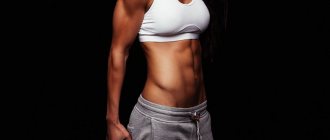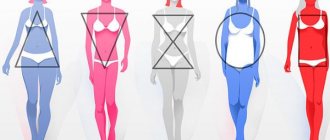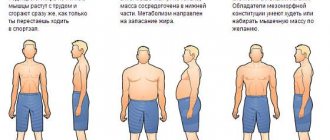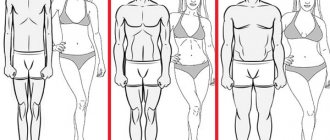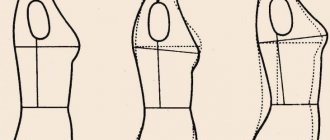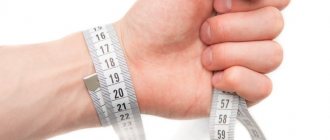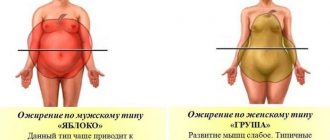What types of figures are there? How does this affect training? Let's talk together with a fitness trainer.
Is the apple or pear body type just a figure of speech? Or does this classification still have a scientific basis? Let's look at what you need to know about your type when planning workouts and creating a diet.
Alexander Karpov
fitness trainer of the World Class network
Your body can look aesthetically pleasing and beautiful with any body type.
Why know your body type?
A person’s endurance, the structure of skeletal muscles, and even the functioning of individual internal organs depend on a person’s constitution. The types also differ in the speed of metabolic processes occurring within the body. This means that, depending on the body type, a person needs to adjust their diet: consume more or less calories, add or reduce the amount of macronutrients in food.
You can prevent the development of many diseases if you correctly determine your body type. For example, the likelihood of developing atherosclerosis and other cardiovascular diseases is associated with a person’s constitution.
Mental characteristics such as intelligence, preferences in certain areas of life: in communication, in spiritual and moral attitudes depend on the constitution. This is explained not only by differences in the external proportionality of the figure, but also by the size of internal organs, including glands that produce certain hormones.
Based on knowledge about the physique, one can find out the tendency to certain behavior, the manifestation of certain emotions, strong-willed qualities, love of love and aggression, as well as sexual potential.
Body proportions are one of the main criteria for assessing human health. Body imbalances are a criterion for disorders of the endocrine, skeletal systems and chromosomal mutations.
Tips for women on how to achieve the perfect figure
All representatives of the fair sex dream of always looking young and seductive. High breasts, a wasp waist, a smooth hip line - this is the ultimate dream for every lovely lady. What is needed to make this cherished dream come true? By what methods can the ideal female figure be formed? Many will answer this question like this: “Personal hairdresser, makeup artist, cosmetologist, massage therapist and nutritionist!” But no! To do this, you only need the desire of the woman herself to take care of her appearance regularly. To find the figure of your dreams, there are several effective ways: physical exercise, body wraps and massage of problem areas using anti-cellulite compounds. Let's look at each of them in more detail. Massage techniques that help model a beautiful silhouette are easy to learn. The main thing here is movement. They must be squeezable. It should be noted right away that this is a rather painful procedure. After it, bruises often remain on the body. But the extra centimeters on the waist, hips and stomach go away quickly. It is enough to perform a massage every other day for a month. And, of course, we should not forget about creams and oils that make this procedure more effective. Wraps also bring very good results in the fight against extra pounds. To do this, you will need a cosmetic product (prepared yourself or purchased in a store), plastic cling film, a warm terry robe and 40 minutes of free time. After taking a shower, we rub the whole body with a hard towel, apply the wrapping mixture, wrap ourselves in film, wrap ourselves in a warm robe and lie down on the sofa to rest for half an hour. Some lovers of this method claim that they perform physical exercises during the entire procedure, thinking that in this case the result can be achieved much faster. But it’s quite difficult to train while wrapped in film. And the next chapter is devoted to what physical exercises will help you form a beautiful figure. The main rule here is regularity of training.
Types and body types
Physique and constitution are similar, but not equal concepts. The somatic constitution presupposes 1 of 3 types, which are practically never found in their pure form. The constitution not only determines the parameters of the body at the moment, but also predicts its future characteristics.
Body type (objective indicators) is the proportions of the body, taking into account age, race, indexes and gender differences. The length of the limbs, the volumes of individual body segments relate to the characteristics of the physique. In addition, body characteristics include the development of muscle and the amount of fat tissue.
The constitution in a broad concept defines not only the physical characteristics of a person, but also the characteristics of the psyche, metabolism and the functioning of individual body systems.
If the physique can be changed throughout life by resorting to certain lifestyle changes, then the human constitution is genetically stable.
In the somatic constitution of a person, there are 3 body types:
- Asthenic (dolichomorphic) – thin-boned.
- Normosthenic (mesomorphic) – normoskeletal.
- Hypersthenic (brachymorphic) – large-boned.
People with an asthenic physique have a predominantly elongated body and longitudinal dimensions.
They are not prone to the formation of fatty and muscle tissue and have thin and narrow bones. The lungs have an elongated shape, the heart is almost in a vertical position. Mesomorphs are people with average body parameters. They can build muscle and fat tissue with less effort than asthenics.
Hypersthenics have well-developed muscles. These people have transverse (horizontal) dimensions and are prone to fat accumulation. Hypersthenics are low, the heart is located transversely, the diaphragm is higher than in other types. The lungs are wider and shorter, the intestines are located mainly horizontally. Another classification has gained the greatest popularity in the West.
Body types are divided into:
- Ectomorphic.
- Mesomorphic.
- Endomorphic.
Parallels can be drawn between these types and the classification of somatic constitution. For example, endomorphs have features of an asthenic physique.
The names of the types come from 3 leaves of the embryo:
- External (ectoderm) - is the beginning of the nervous system, skin and glands.
- Middle (mesoderm) - forms bones, muscles and the cardiovascular system.
- The internal (endoderm) is the future digestive system and respiratory tract.
Physique, which includes the concept of “human constitution,” means not only the size of the body, the ratio of its objective indicators, but also the characteristics of its hormonal and immune system.
The concept of “somatic constitution” defines features, but not the type of figure. It differs among children, adolescents, young adults, and older adults. Parameters can change throughout life, be inherited and vary within established norms. In determining body type, parameters such as proportion indices, limb size ratios, percentages of fat, muscle and connective tissue play a role.
1920s: Flappers
0
Flappers were the nickname for the emancipated young girls of the 1920s who personified the Roaring Twenties generation. The girls were finally able to take off their corsets and take a deep breath. The flapper ideal of beauty was associated with youth and vigor; short haircuts, a thin, boyish build, and knee-length dresses and skirts with a straight silhouette and low waist were in fashion.
Female body types
The shape of a woman's body is made up of the ratio of muscles, fat and bones. A figure cannot be exclusively correct or incorrect: it is only a set of physical features to which aesthetic significance is attributed.
The “femininity” of the figure is strongly influenced by the sex hormones estrogen. Thus, with a lack of appropriate hormones, a woman’s figure may more closely resemble a man’s.
A feature of the female figure is the larger volume of the hips and chest compared to the waist. The ratio of these parameters (girths) is a decisive factor in determining a woman’s body type.
Each female figure is specific in its own way. Pure body types are extremely rare.
Based on statistical data, there are 4 most common body types:
- Rectangular (banana) - slight differences in the volume of the chest, waist and hips. These differences do not exceed 9 inches (23 cm). Fat tissue is distributed throughout the body mainly in the buttocks, breasts, cheeks and abdomen.
- V-shaped (apple) – women with this body type have wide shoulders and narrow hips. They are characterized by fragile, thin legs. Adipose tissue is distributed mainly in the abdomen, cheeks and chest.
- Triangular (pear, guitar) - resembles a triangle with an acute angle upward. With an increase in the percentage of adipose tissue, the volume of the waist and upper abdomen increases. At the same time, a woman’s shoulders are narrower than her hips. The waist is not clearly defined.
- X-shaped (hourglass) - in women with this type of figure, the difference between the waist, chest and hips is most pronounced. Moreover, the chest and waist volumes are approximately equal. As the percentage of adipose tissue increases, the volumes of the lower and upper parts of the body increase.
There is also a definition of “ideal” leg shapes.
These standards were introduced by Alexander Artemyev. If a woman's legs, brought together, touch only at the knees, shins and ankles, then they are considered ideal. A body type whose objective indicators do not go beyond certain values is considered normal. Women with this body type are the most attractive to men, based on sociological surveys. The most attractive body shapes are considered to be triangular and X-shaped.
The aesthetics of the female figure is determined by certain evolutionary reasons. For example, a woman with wide hips is considered beautiful.
Difference in breast size
Most often, the size of the mammary glands in girls differs. The difference in volume can be barely noticeable, and sometimes it is pronounced. This feature is characteristic of all women on the planet. Possible causes include differences in the density of the breast glands, the size of the breast pocket, and elasticity, which is not the same on each breast.
Another feature of the female breast is the fact that it can change due to surgical intervention. The mammary glands contain many nerve endings. Their stimulation can provoke tissue growth within 25% of the original value.
Male body types
Equally important is the ability to select clothes according to the shape of your figure for men. Men's fashion is no less developed industry than women's. Moreover, over time, society’s preferences in style and rules for selecting certain things change, but the relevance of the choice of material, color and proportion of men’s clothing is never lost.
In addition, the type of male figure plays an important role in bodybuilding. So, a man, knowing his body type, will be able to choose the most suitable type of nutrition and training. For example, intense interval training on certain body parts is suitable for men with a rectangular body type.
Unlike women's body types, men's are not as thoroughly researched. Therefore, their selection is purely conditional. Another determining factor in the separation of figures is the presence of subcutaneous adipose tissue. Considering that it is distributed throughout the body depending not on the figure, but on the body type.
However, many sources indicate 4 main types of male figures:
- Triangular – men with a triangular body type have broad shoulders, a narrowed waist and hips. This type of figure is the most attractive for modern women, according to sociological surveys. Triangle men professionally engage in sports that exclude intense strength training. For example, gymnasts may have such a figure.
- Trapezoidal – the difference between men with a triangular and trapezoidal body shape is the presence of fat in the middle part of the body, at the waist. Therefore, the transition from wide shoulders to narrow hips is smoother. It is believed that a man with a trapezoidal figure will not be able to lose weight. However, modern medicine claims that anyone can lose weight by following nutrition and exercise recommendations. Men with a trapezoidal body will simply have a more difficult time than those with a triangular figure.
- Rectangular - the difference between the volume of shoulders and hips in men with this type of figure is practically not visible. They usually have a thin build and a broad chest. Rectangles should be careful about the selection of protein-containing foods and training. Typically, these men have the hardest time gaining muscle mass. To do this, you need to increase the amount of protein in your diet and start intense strength training. Moreover, it is important not to cut the number of incoming calories so that the body does not burn its own, already few, muscles for the sake of the necessary macroelements.
- Oval - these are, as a rule, overweight men, owners of a “beer belly”. Their waist is noticeably wider than their hips and shoulders. At the same time, they cannot always be called fat - only the stomach stands out against the background of thin limbs. This could be a problem with visceral fat. This type of fat accumulates on internal organs and is formed due to high consumption of fatty foods and fructose. Another reason for an oval figure is an increased amount of female hormones. This will influence not only a man’s appearance, but also his behavior, type of thinking and tendency to engage in certain actions.
The body type, the objective indicators of which fit within the boundaries of the triangular type, is most attractive to women. Based on sociological surveys, it was concluded that women like developed arm muscles, a wide chest and an overall fit, slender physique.
These qualities are achieved only through persistent long training. To achieve the desired result, it is better for men to avoid cardio training, which is mainly aimed at reducing subcutaneous fat, and do strength training to build muscle tissue.
Hemisphere connection
As a result of numerous scientific studies, comparisons have been made between the nature of neural connections in men and women. As it turned out, a woman’s brain hemispheres have a tighter relationship with each other than a man’s.
For this reason, women adapt better to routine activities. The brains of men and women function completely differently:
- men have more developed areas of the brain in each hemisphere, and women win in solving problems based on the interaction of the hemispheres and the combination of several types of activities;
- effective performance of motor functions, spatial thinking, speed and accuracy tests are better for men;
- The integration of analytical and intuitive information is more effective in women, which is why they are considered better in social skills.
Characteristics of body proportions
Proportions are the relationships between certain parts of the body. The parameters are not absolute, exact values, but relative torso and limbs. Body proportions change throughout a person's life: they will be different in children, adolescents, adults and the elderly. For example, the older a person gets, the smaller his skull becomes in relation to the length of his body.
The generally accepted method of measuring body proportions is the index. Its essence is that a smaller size (of body parts, limbs, volume) is correlated as a percentage to another, larger size. The parameters are the volumes of the shoulders, waist and hips, and the length of the limbs.
Based on the index of ratios of body size and length, the following types of proportions are distinguished:
- Brachymorphic. These are people with a wide body. The limbs, relative to other types of proportions, are short.
- Dolichomorphic. People with an elongated torso. Hands reach the middle of the thigh or underlying points. The main volumes are relatively narrow.
- Mesomorphic. They occupy an intermediate milestone. These people do not have a pronounced elongation or breadth of body.
Muscle and fat tissue are distributed throughout the body in a similar way to body types, since proportions and body types are determined based on similar parameters.
The proportions of the human body also depend on gender. For example, women differ from men in having a wider pelvis and smaller shoulder circumference. In addition, women's legs are longer than men's.
Constitutional types are also distinguished based on body proportions. They are determined by genetics and are inherited. Body type (objective indicators) is individual for each person. Depends on gender and age. A child, for example, has shorter legs, a large head and an elongated body.
The length of a newborn's leg is 0.25 the length of an adult's leg. Thus, a newborn’s leg is 4 times smaller than an adult’s leg.
Color perception
In women, the perception of the palette of shades is more perfect in comparison with the color difference in men. Therefore, representatives of the fair sex see the environment as more attractive or shocking, respectively. This feature of color analysis depends on the hormone testosterone, which is responsible for the receipt of signals from visual receptors.
According to scientists, such a significant difference is inherent in a woman’s body from birth, since it is determined by her type of activity, for example, gathering. Thus, a woman sees shades more clearly, but a man notices movement in all its manifestations, since he is supposed to be a hunter.
Definition of indicators
When determining body type, not only the measurements of certain parts of the body are taken into account, but also parameters such as the width of the chest, abdominal cavity, and the ratio of muscle and fat tissue in the body.
The main indicators of a person’s physique are height, weight, gender and age. It is these parameters that are necessary for calculating the body mass index, determining the type and proportionality of the physique. The main indicators are known to almost everyone and are often used by doctors to diagnose a patient.
Additional (optional, but adding reliability to the results obtained) are measurements of the chest, waist, hips, lower legs, neck, shoulders and other parts of the body.
Using this data, you can find out the ratio of fat and muscle tissue, and also suggest in which part of the body the body tends to accumulate fat. It can also diagnose the risk of pathology. For example, in a person with elevated stress hormone cortisol, adipose tissue is stored at the hip level.
Additional parameters are used by people who play sports professionally. They need to maintain the desired physical shape, the percentage of muscle and fat tissue.
The results of the calculations are the following indicators:
- BMI (body mass index).
- BFI (body condition index).
- BBI (body obesity index).
- Body fat percentage.
- Percentage of muscle mass.
The first beauty contests
Nowadays, various competitions are very common in which the most attractive of the young beauties is chosen. The first documented beauty pageants appeared in Corinth in the 5th century BC. The ruler of the city approved a holiday in honor of the goddess of the earth. The most beautiful Greek women of that time then appeared before his eyes. Later, this tradition spread to other areas of this country: the city of Athens, the island of Lesbos in the Aegean Sea. And in Ancient Babylon there was a kind of auction to which the most beautiful girls were invited. Each of them was assigned a price for which any man could buy her to marry her. And here everything mattered: the beauty’s ideal figure, face, hair. If in this case the winners received a wealthy husband as a reward, then in Ancient China such competitions ended in bloodshed. The most beautiful girl was sacrificed to the deity. The winner had to be very petite with tiny legs, graceful arms and delicate white skin. In Russia, we have long had a tradition of choosing a wife for the sovereign through competitive selection. At the same time, much attention was paid to the external data and health of the woman.
Ways to determine your type
You can determine your body type using a number of techniques. To use these techniques, you need to know the main indicators of the body. You can measure them using a soft measuring tape.
Formulas for calculating the index can be found on the Internet. There are sites with ready-made calculators, where you only need to enter the necessary parameters. For example, to determine your body type, you need to enter your height and wrist circumference.
By the wrist
The most common option for diagnosing body type. To calculate, you need to know your wrist circumference. Wrist parameters are used because they are relatively constant, even though weight fluctuations occur. Moreover, the narrowest part of the wrist is used for measurement.
The study can also be carried out without a centimeter - for this you need to clasp your wrist with the thumb and middle finger of your other hand.
You can find out your body type in this way by comparing it with the table:
| Body type | Finger position |
| Asthenic | They converge, come into contact with the reserve, overlap. |
| Normosthenic | The fingers touch, but with difficulty and without reserve. |
| Hypersthenic | Fingers don't touch. |
Using a centimeter, you can get the following results:
Body type in women and men can be determined by measuring wrist circumference
| Body type | For women | For men |
| Asthenic | 18 cm or less | 15 cm or less |
| Normosthenic | 18-20 cm | 15-17 cm |
| Hypersthenic | 20 cm or more | 17 cm or more |
According to Pignier's formula
One of the measurement methods is the Pignier index. Otherwise, this is an indicator of the strength of the physique.
During the study, the following body types can be obtained:
- Strong.
- Good.
- Average.
- Weak.
- Very weak.
This index allows you to find out not so much the aesthetic aspect of the physique as the physical one associated with health. Used by doctors to diagnose diseases.
The Pignier formula is convenient to use independently and looks like this: D-(M+O).
D is height; M – body mass, that is, weight; O – chest circumference in cm, measured using a soft tape.
| Body type | Pinier Index |
| Strong | Less than 10. |
| good | From 10 to 20. |
| Average | From 21 to 25. |
| Weak | From 26 to 35. |
| Very weak | From 36 and over. |
By leg length
Another way to determine your body type is to compare the length of your legs with your body height. Moreover, the length of the legs should be measured from the tubercle of the outer side of the thigh to the floor. This method is easy to use and can be used both in the doctor's office and at home. A centimeter is used for measurement.
In addition to leg length, you need to know your height. It must be divided by 2 and the resulting number compared with the length of the legs. The following formula is obtained: L – (D: 2).
L is the length of the legs; D – height.
The result is an index corresponding to a particular body type:
| Body type | Indicators |
| Asthenic | From 6 to 9 cm. |
| Normosthenic | From 4 to 6 cm. |
| Hypersthenic | From 2 to 4 cm. |
In addition to determining your body type, it is also important to know your body mass index, which is no less important for organizing a healthy lifestyle, planning workouts and choosing a nutrition system.
During nutritional correction, it is best to use periodic measurements of the volumes of certain parts of the body. For example, to measure the effectiveness of the chosen nutrition system, you can measure additional indicators once a week or month: waist, hips, shoulders.
Body types are a conditional classification. There is no such thing as a pure body type. Typically, signs of, for example, normosthenic and hypersthenic physique are combined. Objectively measured body parameters are the best determining factors of successful or failed body correction.
Author: Svitkevich Yulia Vyacheslavovna
How to quickly get into great shape. A few recommendations for men
There is an opinion that for representatives of the stronger sex, external beauty is not particularly important. However, modern men for the most part follow today's trend to take care of their face and body. After all, as you know, the image of a successful person is unlikely to be associated with a plump and flabby uncle. Therefore, it is worth giving some tips to men on how to get an ideal figure by working out at home or in the gym. First, try to exercise regularly. Strength training on machines is an ideal option. If you don't have time to go to the gym, do exercises at home. To do this, you should definitely purchase dumbbells. Use every free minute to do push-ups or squats, for example. Be sure to do back straightening exercises. Good posture is important for an ideal figure. Secondly, eat right. Try to avoid fried and spicy foods. Many men underestimate the impact of alcohol on their health and appearance. Even a seemingly “innocent” drink like beer, when consumed regularly, can nullify all efforts to build a strong, beautiful figure. It’s not for nothing that there is such a thing as a “beer belly.” Thirdly, try to look into the solarium sometimes. After all, as we found out, women value strong, fit, tanned men who exude confidence and health.
1970s: Tall and slender Queen of Disco
0
Thinness continued to be in fashion, but girls also had to demonstrate an athletic physique, and this was facilitated by the craze for dancing and roller skating. Plus overalls, bell-bottoms and highlighted hair. Farrah Fawcett became a sex symbol of the 1970s, and these posters of a smiling Farrah in a red swimsuit sold millions of copies.

